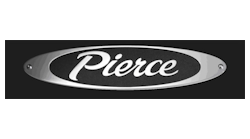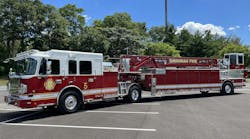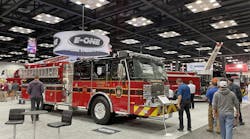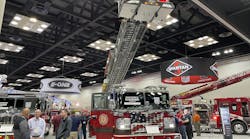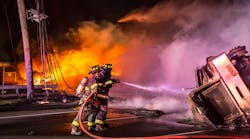When one looks at the technological advancements of fire apparatus over the past 10 years or so, it’s mind blowing. It belies the old fire service adage—200 years of progress unimpeded by progress.
Today’s apparatus are marvels with complex advancements that exceed stuff NASA has shot in to space over the decades. ABS systems, electronic stability controls, radio-frequency controls, touch-screen panels, multiplex electronics, joystick operations, collision avoidance, WiFi hot spots—the list is almost endless.
Pierce Manufacturing, one of the nation’s largest makers of fire apparatus, has over 140,000 options firefighters can build in to their fire trucks.
“We work very hard to integrate everything the end user wants in their apparatus,” said Chad Dolphin, chief engineer of electrical products for Pierce. “We look at what the customer wants and what they are driving towards.”
Technology is quickly evolving
Dolphin points to the electronic evolution of the cell phone as an example of the kind of explosion of technology that’s driving the fire apparatus market. Ten years ago, Dolphin said, people were content with basic phones in their pockets. Five years ago, smartphones started coming on strong and now, that’s what everyone wants and the basic phones are pretty much obsolete, he said.
“We are right on the heels of that when it comes to electronics,” Dolphin said. “They expect that kind of evolution from us as well.”
Dolphin is not alone in those observations. Dave Reichman, Rosenbauer America’s national sales manager, said customers see features and options in other areas of their lives, like automobiles, and they want those things in their fire trucks too.
“There is no doubt that the new high-tech things we see in automobiles make their way into fire trucks,” Reichman said. “Airbags are an example of that.”
While some might not consider airbags high-tech by today’s standards, they were a big deal in the day, considering the options were ABS plastics and foam padding, or worse—steel and formed aluminum.
High-tech came into play as manufacturers tried to figure out how to calibrate the airbag sensitivity so they wouldn’t deploy during the bumps and bruises apparatus endure, especially in big cities when apparatus occasionally bump dumpsters and obstructions out of the way to get to incidents.
“It was a challenge, but we did it,” Reichman said.
Learning from the automotive industry
Dolphin said Pierce works with many of the “big players” in the automotive industry to translate what firefighters see and experience in their driveways to the fire truck markets.
“We work with the auto industry and take the software and technology that already exists and get it to the firefighters,” Dolphin said. “That’s exactly what they’re looking for.
As an engineer and a volunteer firefighter in Wisconsin, Dolphin said his work is exciting and he can get “a little nerdy” when talking about the electronics being integrated in fire apparatus.
NPFA standards dictate technology
While some of the whiz bang stuff is exciting and innovative, both Dolphin and Reichman said firefighter safety is a driving innovation.
“Safety of the firefighter is paramount,” Dolphin said. He added that if the technology is useful in meeting that goal, it is often written into National Fire Protection Association (NFPA) codes and they become industry standards.
Reichman feels the same way. “Anything high-tech that equates to safety is nothing but good,” he said. Reichman, who has decades in the fire truck industry, recalls the days when ABS brakes first came out.
“It was a new option and it was fairly expensive,” Reichman said. “Then, the next thing you know it was a requirement in the next round of NFPA 1901 standards for certain size trucks...That was the start of it.”
Not long after that, electronic-controlled engines found their way into the fire market and Allison Transmission introduced its World transmission, which is now part of the EVS series, Reichman said. Quickly on the heels of that was electronic pressure governors because it really wasn’t possible to control engine speed with a Vernier, or cable, throttle.
Dolphin said it was “crazy” how fast technology moved into the fire market. Pierce now uses 800 electrical supply vendors in the building of apparatus, he said.
From the pressure governor, multiplexing was the next evolution that opened up significant electrical pathways upon which high-tech systems can work and communicate.
Touch-screen technology
Pierce has a Command Zone control system that operates virtually all electronics on apparatus. The touch-screen monitor displays real-time data and diagnostic information ensuring all systems are go prior to the vehicle’s departure. It also shows warning information, seatbelt usage reports as well as optional GPS mapping, tire pressure monitoring, collision mitigation and outrigger placement during aerial operations.
Dolphin said the Command Zone also integrates with scene and warning lights and gives users prognostic and diagnostic information.
Reichman said Rosenbauer also has information telematics on it apparatus that allows the monitoring of trucks over the Internet. The systems are popular on European rigs and, while it’s not brand new, it’s becoming more popular in the United States.
Information about the apparatus location, faults on the apparatus and the vehicle log can be sent to the manufacturer or wherever the end user desires.
“If there’s a fault on the truck, we know it,” Reichman said, noting that the automatic report will provide information that a customer might need a new particular part and they can be contacted for the service.
Aerial technology
Reichman said Rosenbauer has sophisticated aerial controls that are joystick operated. Smart Aerial technology has been in Europe for years and Rosenbauer has had it in the United States for over 10 years.
“People think it’s some sort of magic thing we’re doing, but it’s not really,” Reichman said. “We saw the benefits and looked at it…. Now, very few of our aerials are not Smart Aerials. The benefits are too great to ignore.”
He said the system is very intuitive. “When you pull up with the Smart Aerial joystick, the aerial goes up,” he said. He added even the most inexperienced operator can safely fly an aerial without fear of breaking the apparatus.
Rosenbauer can still provide the three-stick aerial controls from 20 years ago for departments that prefer that system, but when they see the smart technology, they’ll often change their minds.
“Once they operate with a joystick, and they see the aerial does exactly what they want, you can see it in their faces,” Reichman said. “It’s pretty nice and it makes you job easier and who doesn’t want that.”
For the “doubting Thomas’” in the world, and there are many, Reichman said manual override controls are in the operator’s pedestal. So, in the unlikely event the electronics fail, the aerial and the monitor can still operate.
Improving technology
There are segments of the firefighting population who are suspect of technology, but both Dolphin and Reichman say vendors are continually working to make products fail safe. Reichman mentioned Rosenbauer’s use of Controller Area Network (CANbus), which was developed in the aviation industry and used in airplanes since the 1980s. CANbus is a vehicle standard allowing microcontrollers and devices to communicate with each other in applications without a host computer.
“It’s been in the industry over 20 years, easily,” Reichman said. “It’s proven itself. In the fire service, we like redundancies, and that’s fine, but we don’t see failures. Still, we have manual backup.”
For Dolphin, technology is a way to make things safer for firefighters and give the market what it wants.
“We try to keep our pulse on the market,” he said. In many cases, the fire service is at the mercy of the technology manufacturers and vendors.
Reichman said because the fire service is such a niche market, it often has to wait for technology to make its way into the over-the-road trucking market before it becomes affordable for use in the fire service.
“As with any high-tech option, you have to consider whether the benefit outweighs the price,” Reichman said. “Price is always going to be a factor.”
Dolphin agrees and said “the big car companies” drive innovation and the fire service then decides whether it has value to firefighters.
“We have to balance what customers want and what the industry is ready for,” Dolphin said. “It’s a fun spot to be in. We have to look at what provides value and not just provide it because we can.”
He added that firefighters don’t take kindly to gimmicks and if a manufacturer provided something questionable or just a novelty, firefighters would certainly let them know.
“They’d have some colorful language no doubt,” Dolphin said. “We have to stay grounded in what we do.”


